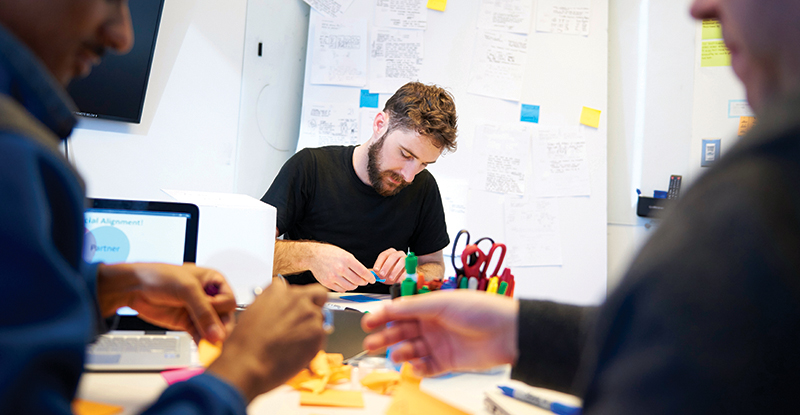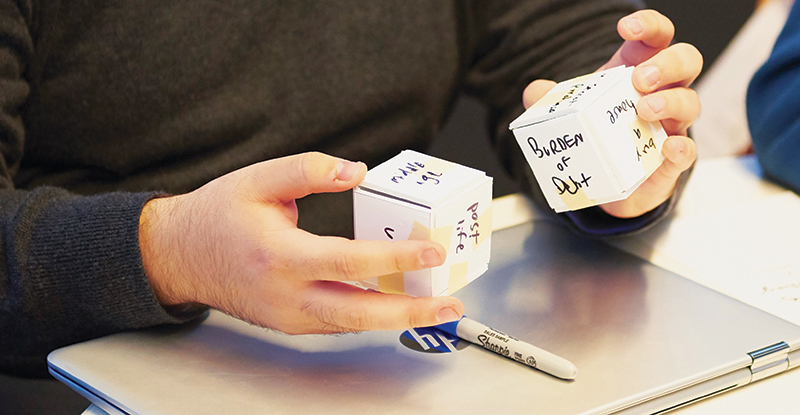Dollars and Design Sense
Students in Northwestern's MMM Program combine design thinking and business expertise in a collaborative initiative with Visa.
When Visa’s Shiv Singh wanted to explore how to help banks and merchants better interact with their customers, he had no shortage of resources to help him.
As Visa’s senior vice president of innovation and strategic partnerships, Singh had access to an expansive team of designers and creative minds working in Visa’s nine innovation centers around the world. He also could leverage a network of global startup companies thanks to Visa’s Everywhere Initiative, a program that tasks startups to help solve the payment and commerce challenges of tomorrow.
Ultimately, Singh turned not to another group of designers nor the leaders of a technology startup, but rather to a team of students in Northwestern’s MMM Program: Mark Sullivan, Adam Attas, Rene Peters, and Zachary Richner.
“At Visa, we believe our future is driven by non-traditional partnerships,” Singh says. “We thought if we took the same approach with an interdisciplinary academic program like MMM as we do with the startup community, we could gain a different perspective on the business challenges our customers face.”

Integrating Design with Business, Academia with Industry
The MMM Program is an immersive dual-degree graduate program that integrates business education with design innovation. MMM graduates receive an MS in Design Innovation from Northwestern Engineering and an MBA from Northwestern’s Kellogg School of Management.
"The MMM Program empowers future business leaders to innovate using creative and critical thinking skills,” says Greg Holderfield, co-director of the MMM Program and director of Northwestern Engineering’s Segal Design Institute.
"Graduates are uniquely positioned to use design thinking to identify the right problems and lead organizations to solve them well. That combination of skills enables lasting innovation and impact.”
For MMM students, the Business Innovation Lab course is the program’s capstone educational experience, an opportunity to apply the design innovation and business management lessons learned in the classroom to actual business problems in collaboration with a leading global organization, like Visa.
"The Business Innovation Lab is one of the reasons why I chose the MMM Program,” Sullivan says. “To work with a client like Visa is very unique. You might find an opportunity like this some other place, but you’d have to look hard for it. Here, working with a company like Visa is built into the program.”
Pivoting Toward Human-Centered Design
Interested in leveraging emerging technologies in the finance sector, Visa originally tasked the team to explore how biometrics—retina scans, fingerprints, facial and voice recognition—could improve banking experiences for customers. As the team members began their research, however, they shifted their focus to how couples manage financial decisions together.
“The human-centered design process focuses on gaining insights from one-on-one interactions. Companies often make a product just because they can. Human-centered design makes sure you address a genuine human need. The in-person feedback often reveals the real problem.”
Why pivot? The team credits the human-centered design process, one of the MMM Program’s guiding principles that inform design thinking.
"The human-centered design process focuses on gaining insights from one-on-one interactions,” Peters explains. “Companies often make a product just because they can. Human-centered design makes sure you address a genuine human need. The in-person feedback often reveals the real problem.”
The team spent six weeks conducting more than 40 in-person interviews, leveraging their own extended network, placing an ad on Craigslist, and working with professional recruitment agencies to find candidates. When asked about their attitudes toward finances, respondents consistently mentioned the difficult transition that occurs when a couple joins its finances and begins making financial decisions together.
“They not only must reassess their own view of finances, but they also often have interactions with each other that present challenges,” Sullivan says. “That shaped our focus.”
The team’s anecdotal research revealed how emotions drive major financial decisions made by couples. Planning a wedding, for example, requires both partners to align their expectations of how to allocate their combined financial resources to different expenses from venues to caterers to photographers. What’s more, they must also manage input from family members on how to assign and divide costs. With individual values reflected in such financial decisions, reaching consensus can be difficult.
"There’s more to it than just shelling out cash to pay for something,” Sullivan says. “Money is a very emotional issue, especially for people who feel their backs are against the wall.”
Hearing the first-hand stories made the team wonder how it might make these challenging conversations less stressful. Singh welcomed the new direction.
"When the team presented this shift in focus, we loved it,” Singh says. “It demonstrated an interesting evolution in their approach, becoming more human-centered than technology-centered. They discovered an untapped need we were excited to explore.”
Guided by Industry Professionals
Counselling the team throughout the research phase was adviser Michael Chapman, adjunct lecturer in the MMM Program and senior design lead at global design consultancy firm IDEO. Team members met with him weekly at his office in downtown Chicago, beginning each meeting with a recap of the progress made over the previous week. They then prepared for the week ahead—brainstorming, diagramming ideas on a whiteboard, and talking through anticipated challenges. Chapman described the setting as a “living classroom.”
"I had expectations of what the students wanted to work on and had questions to guide the conversation, but our working sessions were often reactive,” Chapman says. “The environment was not at all like a static lecture. It was more like an actual design consultancy.”
"To pick Michael’s brain for two hours every week was incredible,” Richner says. “He advised the team without micromanaging us. He had a way of prodding us in an almost Socratic way, offering help but letting us do the work and get our feet underneath us.”

Prototypes to get the Ball Rolling
After presenting its initial research findings to Visa, the team embarked on a three-week sprint to design and test potential concepts that could inspire future Visa initiatives. One concept gamified the process of jump-starting financial discussions among couples.
In the game, couples would roll a paper die with one adjective written on each side expressing different emotions, such as “content,” “thrilled,” or “sad.” If the die came up “anxious,” for example, the two would discuss a purchase or payment they felt anxious about in the coming month, six months, and year.
“Couples quickly learned whether they were on the same page or not,” Sullivan says. “Couples often don’t have these conversations at all, or if they do, they’re incomplete. The game showed how an external stimulus can be valuable to spark discussion.”
Another concept simulated the unexpected twists and turns couples encounter as they work toward financial goals. In the exercise, couples would follow their movement across three tracks on a poster board, each leading to a different financial goal, like buying a house or saving for a vacation. The team would present scenarios that impacted movement along each track. A promotion at work allowed couples to move up three spots. A sudden loss of money forced a retreat backward two spots. The exercise tested couples’ ability to prioritize and agree on when to move closer—or farther away—from their goals.
“When people were introduced to a financial setback in the simulation, they really empathized with the situation,” Attas says. “It felt real to them.”
In addition to developing concepts that felt personal to the users testing them, the team designed the prototypes to be adaptable to different modalities, such as physical products or mobile app-based games, and scalable for a large company, like Visa.
"We designed our concepts to promote interaction, to bring out the pleasure of seeing you and your partner aligned on financial decisions or to recognize the need to have more conversations,” Peters says. “To that end, we felt we validated the prototypes and verified that they met a need. There’s a foundation here for Visa to use its resources to build upon the principles these prototypes represent and develop market solutions.”
Lasting Impact
In March 2018, the team traveled to Visa’s San Francisco offices to present its concepts and final recommendations to the company’s core innovation team, which included Singh and several of the company’s in-house design thinkers.
"Visa has been a great advocate for us. With a whole team of people practicing design thinking, they bought in to our work throughout our collaboration. It’s great to know that our ideas have the potential to be put into practice.”
While the meeting marked the end of the MMM team’s work on the project, Visa’s work is just beginning. The company plans to use the team’s prototypes and insights gained from its field research to further explore and develop new innovations that will help couples manage turbulent financial situations.
"Visa has been a great advocate for us,” Richner says. “With a whole team of people practicing design thinking, they bought in to our work throughout our collaboration. It’s great to know that our ideas have the potential to be put into practice.”
Looking back at a whirlwind 10 weeks, Attas admits to a newfound appreciation for the role of design in what he previously thought was an analytical field. “I entered this project hoping to use design to demystify some of the complexities in the finance industry,” Attas says. “I quickly learned how important human-centered design is to this field. When you have conversations with people, you experience life through their eyes, and you understand how things like a 401(k) or a joint bank account can bring tension or happiness. To improve lives using design shows how powerful a tool it can be.”
